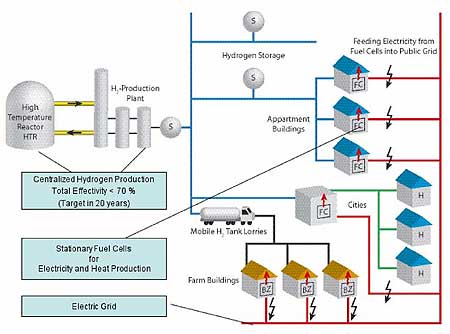

Resumé of Swiss Nuclear Society´s
Autumn Seminar, 2006
by Dr. Peter Leister, Vice-President of the Swiss
Nuclear Society and of the European Nuclear Society
Would it be profitable for Switzerland to enter
into the hydrogen economy?
The seminar’s focus was on the substitution
of fossil fuel based energy for heating purposes using hydrogen
as the energy carrier. Bearing in mind that the seminar took place
last autumn, to publish a resumé now – when the two
parts of the UN Climate Change reports were only recently released
– re-enforces the seminar's original focus. Political and
economical aspects like independence from imports and stability
of fuel prices coincide very much with the requirements for environment
protection and the inevitable obligation to reduce CO2
emissions anywhere in the world, even in Switzerland.
This country imported, in 2005, 610 PJ of fossil
energy for heating, 503 PJ of which came from oil and 107 PJ from
natural gas .
Issues such as the building blocks of the hydrogen
technologies required to replace this amount of fossil fuel, their
availability and reliability were addressed by the different presentations
during the seminar.
The authors of the contributions to this seminar
represent a reservoir of international know-how of the hydrogen
economy in view of H2 production by conventional and
advanced processes (Linde, General Atomics, Le Commissariat à
l'Energie Atomique). Some represent utilities already operating
successfully stationary fuel cells (EnBW) or research institutions
participating in the international Generation IV Initiative Forum
(GIF). The GIF is driving forward high temperature reactor technology
towards its successful application as a heat source forH2
production or for desalination (Paul Scherrer Institute ) or for
use by an international engineering company at any kind of power
generation plant (Colenco).
Most of the presentations were given in German
but several were in English. Access to all of the contributions
is possible via the home page of the Swiss Nuclear Society at:
www.sns-online.ch/fs2007.
The lectures presented in the seminar followed
a logical sequence starting with an overview over the current
Swiss energy balance, a definition of the building blocks of a
hydrogen economy, its requirements and constraints and progressing
to a view of what Switzerland has contributed to the further development
of modern hydrogen technologies. Moreover, experiences obtained
with an initial industrial-scale application were described. A
major part of the seminar was dedicated to high temperature processes
for hydrogen production and the corresponding heat sources via
the high temperature nuclear gas cooled reactors, its further
development and programmes for improving materials were dicussed.
Last but not least, cost calculations for building up a hydrogen
economy in the transport sector, as well as for stationary purposes,
were presented.
A. Böhner presented data
on Swiss [presentation 1] energy consumption and production based
on how the various energy carriers in the different consumption
areas offer potential for being replaced by hydrogen and what
would be an acceptable technological scenario for using centrally-generated
hydrogen to replace imported fossil fuel especially, natural gas
for heating Swiss households, public buildings and heat consuming
industrial processes. He presented a strategy for the installation
of a hydrogen economy and identified its risks and merits. The
results of his economical calculations are mentioned at the end
of this resumé.
P. Dietrich then explained [presentation
2] which Swiss know-how is available and applicable to a hydrogen
economy scenario based on fuel cells. Various Swiss institutions
are involved in the further development of components for conventional
solar energy based H2production, for mobile and stationary
fuel cell technology and for H2 storage technologies.
For example, Swiss PSI and Material Research EMPA co-operate in
the area of metal hydrate storages for hydrogen - a very promising
technology. When it comes to an industrial-scale demonstration
for mobile applications this technology has already been used
for snow track vehicles and for the Michelin/PSI HYLIGHT-Car®.
Predictions about when the industrial application of large-scale
stationary metal hydrate storages is likely to be on stream range
from a period of between 10 to 15 years.
An overview of how state-of-the-art stationary
fuel cells can supply apartment buildings, hospitals, etc. by
simultaneously producing power and heat production on an industrial
scale was presented by B. Heyder in presentation
3. He emphasised that this kind of technology is a mature one
based on natural gas being fed into the fuel cells. If hydrogen
could be switched over to immediately, its greater efficiency
would be clear for all to see.
R. Schiffbauer dedicated presentation
4 to state-of-the-art industrial hydrogen production, pointing
out that hydrogen production is a very traditional industry that
has worked profitably for more than 100 years. To date, hydrogen
is not so much used as an energy carrier but more as a raw material
for chemical processes like steam reforming. Furthermore, the
distribution of hydrogen via pipelines has proven to be a very
safe technology for many decades since the last third of the 19th
century, when the gas mains of larger cities distributed gas to
households that contained a hydrogen content of more than 50%.
For more than 40 years pipelines conveying pure hydrogen have
been maintained very safely in European industrial centres like
the Ruhr and the area around Lille, France. These pipelines are
several hundred kilometers long. Even today existing natural gas
pipelines can be converted to hydrogen distribution without much
of an effort. Indeed, the transition from pure natural gas to
hydrogen operation would not create major technical problems.
Introducing a hydrogen economy would hence not require gas and
hydrogen pipelines in parallel during a transitional period.
Hydrogen production by steam reforming of hydrocarbons
from natural gas has largely replaced the old electrolysis process
(world wide this now only accounts for 1% of total H2
production). Now, however, it is no longer conceivable to use
old electrolysis or the steam reforming technology in a hydrogen
economy. Swiss experts are of the opinion that renewable energies
will never meet the requirements of economical hydrogen production.
L. Brown underlined, in presentation
5, how the only reliable and ecological – hence sustainable
- hydrogen production is via nuclear high temperature reactors
(HTR) combined with a high temperature chemical process (the sulphur-iodine
process) This process, developed by General Atomics, was finally
selected amongst 370 H2-generating chemical processes.
The feature of this process is the use of inorganic chemicals
only (Iodine and Sulphur) and water as the feeding material, to
produce H2 and O2. Depending on its chemical
effectiveness losses of iodine have to be compensated for. The
selection of suitable corrosion-resistant vessel and pipe materials
make the equipment expensive.
This High Temperature Water Splitting process
absorbs most of the reactor’s fission heat and has the potential
to achieve up to 70 % efficiency. The total efficiency of the
chain of hydrogen production, distribution and conversion of fuel
cells into power and heat is comparable to that of modern natural
gas burning co-generation or district heating plants. It has the
advantage of zero consumption of fossil resources and does not
emit climate change-inducing carbon dioxide. The fundamental viability
of this water splitting process will be demonstrated by 2010 and
in 2020 an industrial scale engineering demonstration plant on
will be operational.
State-of-the-art HTR technology, its international
development and the time required for further materials research
was covered by presentations 6 and 7. Presentation 8 was dedicated
to cost considerations of the several building blocks needed to
support the hydrogen economy in a small but well-industrialized
country like Switzerland and in a larger industrialised nation
like France.
In presentation 6, K. Foscolos gave
a short overview of recent developments in reactor technologies
and presented in detail HTRs - both existing ones (Generation
IV) and future ones like improved HTRs called “VHTRs.”
The latter will produce fission heat at a level of up to 900°
centigrade. Switzerland is an active member of the GIF, in which
the most important nations contributing to this research co-operate
with each other.
The experts believe that the full potential
of these reactors must be exploited so that they can become the
work horses of a hydrogen economy. Light water reactors will play
a minor role in such a scenario. As far as the availability of
uranium as a main fuel resource is concerned it is concluded that
– in contrast to the declarations made by “anti nukes”
– by using the advanced VHTRs uranium becomes nearly inexhaustible
since uranium can be extracted cost effectively from sea water
by using heat from VHTRs. Such a process makes uranium in sea
water exploitable.
One important step towards the operation of VHTRs
concerns the selection of materials for reactor components, which
must be resistant to very high temperatures. According to W.
Hofelner [in presentation 7] at least 15 years of further
development are required to make VHTRs available on an industrial
scale within 25 years.
F. Werkoff devoted his lecture
[presentation 8] to economic calculations of the investment costs
for the H2 economy and presented helpful formulae.
In addition, he explained the High Temperature Electrolysis (THE)
process working during the vapour phase of water. This new process
has, above all, the potential to compete with the S/I process
but with the advantage that THE can be used with heat sources
like conventional biomass, domestic incinerators and even light
water reactors to produce hydrogen. For France it was calculated
that within the next 45 years 85 % of the French car and truck
fleet could be converted to using H2 fuel cells requiring
16 light water reactors of the type EPR instead of 75 HTRs. When
it comes to using LWRs in a hydrogen economy, the CEA obviously
differs from the HTR-community.
This precise and detailed information lead the
authors of presentation 1 to the conclusion that with respect
to the different building blocks needed to support a hydrogen
economy only two blocks determine the critical path of a solution
tailor-made for Switzerland:
-
cheap, large scale H2 storages based on metal
hydrates
-
suitable, corrosion-resistant materials for VHTRs
The corresponding time span of 15 years would
enable the start-up of a 20 year demonstration project aimed at
achieving a smooth transition from imported natural gas to hydrogen.
Such a project would comprise of the following steps:
-
Installation of stationary fuel cells into
every newly constructed apartment building with more than
10 flats for a period of 20 years
-
Connection of fuel cells to the electricity grid for feeding
generated power into the grid
-
Construction of local H2-gas grid sections
-
Supply of fuel cells first by natural gas and later on by
conventionally produced H2 supplied by tanker lorries
-
Successive construction of H2-storage tanks at
strategic points of the gas grid (according to the progress
with the availability of metal-hydrate storages)
-
Start of the design and construction of one HTR- H2
production plant, comprising of two 600 ME reactor blocks
-
Adaptation of existing gas grid to increase H2-concentration
-
Connect H2-plant to gas grid
-
Increase H2-content of gas grid to 100 %
This sequence of steps corresponds to the illustration in Fig.1,
starting with the part on the right hand side (stationary fuel
cells, initial supply of FC by natural gas from public grid then
mobile H2-transportation, installation of H2-storages
and finally realisation of a HTR & H2-generation
plant, lefthand side)
This sequence of steps would:
-
enable Swiss small and medium sized enterprises to be prepared
for switching over to an H2 infrastructure
-
make consumers and suppliers acquainted with use of H2
-
enable reimbursement of fuel cell produced electricity fed
to the grid
-
allow for the correction of any project that shows misleading
results
-
give the utilities time to master the decentralized production
of electricity by the fuel cells
After a successful demonstration of the feasibility
of this small part of a hydrogen economy in Switzerland another
15 years period should be sufficient to extend the hydrogen economy
to cover the whole of Switzerland. The calculation on an investors
level show that within this demonstration project, starting with
conventionally produced H2, total operational cost
of this part of a Swiss Hydrogen Economy is significantly below
the operational cost of the equivalent gas/oil burning for the
apartment houses (gas/oil prices exceed .095 US$/kWh and .0702US$/kWh
respectively). The question raised in the seminar’s title
can now clearly be answered.
Moreover, the reduction of the CO2
emissions by the demonstration project corresponds to 34 % of
consumption of gas and oil fuel used for heating so far. It is
about three times the amount of the energy forecast to be produced
in Switzerland in 2035 by renewable energy. If all Swiss gas and
oil consumption for heat production were to be replaced by hydrogen
Switzerland could contribute fighting climate change and be a
model for other industrial nations to follow. The technologies
exist and are available. In a hydrogen economy the savings obtained
from constant energy prices would be considerable.

Fig. 1 Concept of a Demonstration
Project for replacing fossil fuel by hydrogen and fuel cells to
heat private and public houses (source Nuclear News, September
2001)
References
|
[1] |
Böhnert, A. and M. Nandakumar,
Colenco Power Engineering Baden-CH
Stepwise Entering into the H2-Economy in Switzerland,
the View of an Investor
|
|
[2] |
P. Dietrich, Paul-Scherrer Institute Villigen-CH
Swiss Research Contributions to Building Blocks of H2-Economy
|
|
[3] |
Heyder, B., Kessler, A., Edel, M, EnBW,
Karlsruhe-DE
Experiences with Stationary Fuel Cells for Industrial and
Household Heating
|
|
[4] |
R. Schiffbauer, Linde-PanGas, Switzerland
Industrial H2-Production and Experiences in Operating
H2-Distribution-Pipelines
|
|
[5] |
L. Brown, General Atomics, San Diego,
CA
Large scale Hydrogen Production by HTR: The Sulphur Iodine
Process (engl.)
|
|
[6] |
K. Foskolos, Paul-Scherrer Institute Villigen-CH
High Temperature Reactors for H2 -Production
|
|
[7] |
W. Hoffelner, Paul-Scherrer Institute
Villigen-CH
Technological Evolution and Materials for HTR and VHTR
|
|
[8] |
F. Werkoff, Centre du CEA –Saclay,
Paris
Hydrogen from helium cooled reactors: can we compare the
thermochemical Sulphur/Iodine cycle and the High Temperature
Electrolysis? (engl.) |
|





